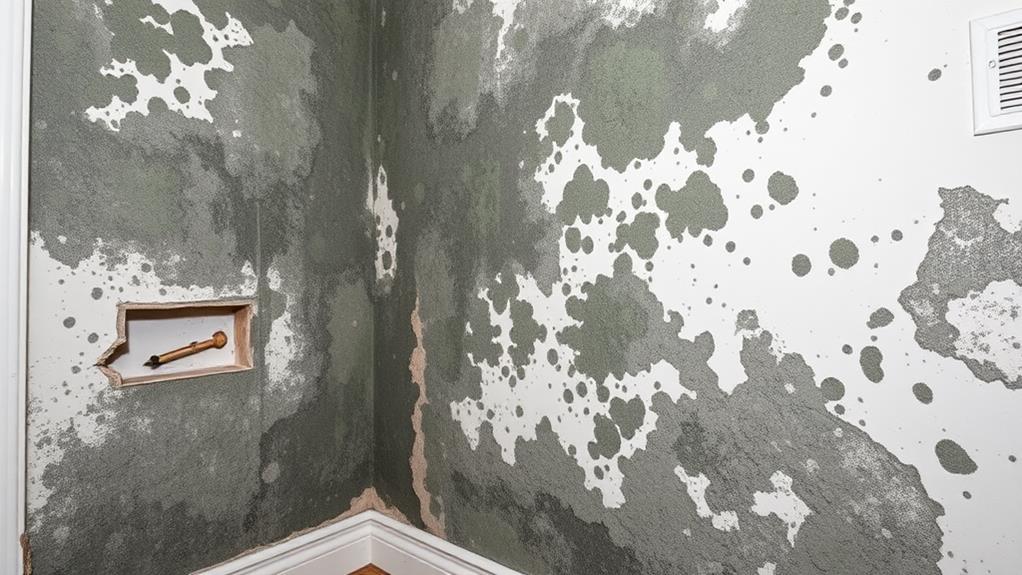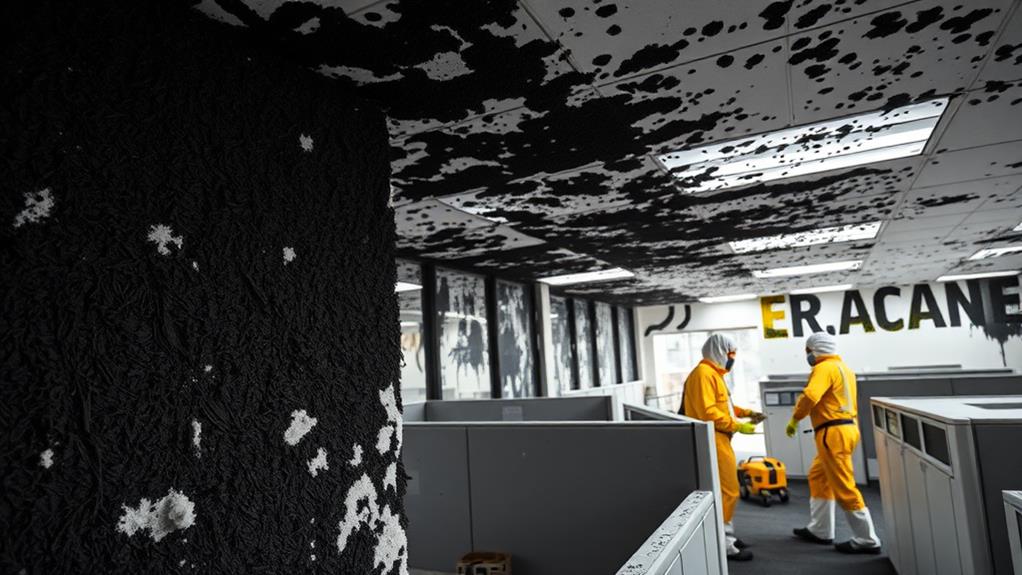Professional mold remediation services should be called when mold growth becomes extensive, covering more than 10 square feet. Persistent musty odors, recent water damage, or flooding also warrant expert intervention. If health symptoms like respiratory issues or skin rashes appear, especially indoors, it may indicate a serious mold problem. Failed DIY removal attempts or suspicions of hidden mold growth are additional reasons to seek professional help. For large-scale commercial infestations, specialized equipment and expertise are crucial. Professional remediation ensures thorough inspection, proper containment, and effective treatment to address the root causes and prevent recurrence. The following information provides deeper insights into recognizing when expert assistance is necessary.
Extensive Visible Mold Growth

Frequently, extensive visible mold growth indicates a severe underlying issue that requires immediate professional attention. When mold covers large areas, typically exceeding 10 square feet, it's crucial to engage professional remediation services. This level of growth suggests prolonged moisture exposure and potential structural damage.
Extensive mold growth often penetrates beyond visible surfaces, infiltrating porous materials like drywall, insulation, and wood. DIY attempts to clean such widespread contamination can inadvertently spread spores, exacerbating the problem. Professional remediators possess the necessary equipment, protective gear, and expertise to safely contain and remove large-scale infestations.
Moreover, extensive mold growth may indicate hidden water sources, such as leaky pipes or roof damage, which professionals can identify and address. They can also assess the full extent of the contamination, including areas not immediately visible. Professional remediation ensures thorough mold removal, prevention of future growth, and restoration of affected areas to a safe, habitable condition. Given the health risks associated with prolonged mold exposure, swift action by qualified professionals is essential when facing extensive visible growth.
Persistent Musty Odors
Permeating throughout a home or building, persistent musty odors often signal the presence of hidden mold growth that requires professional remediation. These odors are typically described as damp, earthy, or reminiscent of rotting wood. While the source may not be immediately visible, the smell indicates that mold spores are actively releasing microbial volatile organic compounds (MVOCs).
Persistent musty odors can emanate from various sources, including wall cavities, crawl spaces, attics, or areas behind furniture. These hidden mold colonies can develop due to ongoing moisture issues, such as leaky pipes, poor ventilation, or water intrusion. Even if the initial water source has been addressed, established mold growth can continue to thrive and produce odors.
Professional mold remediation services are essential in these cases because they possess the expertise and equipment to locate and address hidden mold growth. Remediation experts use specialized tools like moisture meters, thermal imaging cameras, and air sampling devices to pinpoint the source of the odor. Once identified, they can develop a comprehensive plan to remove the mold, address underlying moisture issues, and eliminate the persistent musty smell, ensuring a healthier indoor environment.
Water Damage or Flooding

Water damage or flooding events pose significant risks for mold growth and often necessitate professional mold remediation services. When a property experiences water intrusion, whether from natural disasters, plumbing failures, or other sources, the moisture creates an ideal environment for mold to thrive. Mold can begin to grow within 24-48 hours of water exposure, making swift action crucial.
Professional mold remediation services are essential in these situations due to their expertise in handling extensive water damage and potential mold infestations. These specialists possess the necessary equipment to thoroughly dry affected areas, detect hidden moisture pockets, and identify mold growth that may not be visible to the untrained eye. They can also assess the extent of the damage and determine if structural components have been compromised.
Furthermore, professionals can implement proper containment measures to prevent mold spores from spreading to unaffected areas during the remediation process. They utilize advanced techniques such as HEPA filtration and negative air pressure to ensure thorough mold removal and decontamination. Engaging professional services after water damage or flooding is critical to prevent long-term mold issues and protect both the property and its occupants' health.
Health Symptoms Appear
The emergence of health symptoms often serves as a critical indicator that professional mold remediation services are needed. Mold exposure can lead to various health issues, ranging from mild to severe. Common symptoms include respiratory problems, such as coughing, wheezing, and shortness of breath. Individuals may also experience nasal congestion, throat irritation, and eye irritation. Skin rashes, headaches, and fatigue are additional signs that mold may be present.
If multiple household members or building occupants experience these symptoms simultaneously, it strongly suggests a mold problem. Those with pre-existing respiratory conditions, allergies, or compromised immune systems are particularly susceptible to mold-related health issues. When symptoms persist or worsen over time, especially when spending extended periods indoors, it's crucial to consider mold as a potential cause.
Professional mold remediation becomes essential when health symptoms appear, as DIY attempts may inadvertently spread mold spores and exacerbate the problem. Experts can accurately identify the extent of mold growth, safely remove it, and implement preventive measures to ensure the health and well-being of occupants. Prompt action in response to health symptoms can prevent long-term health complications and costly property damage.
Hidden Mold Suspicions

Behind walls, under flooring, and within ceiling cavities, hidden mold can thrive undetected, posing significant risks to both property and health. Suspicions of concealed mold growth often arise from subtle signs that homeowners should not ignore. Persistent musty odors, even after thorough cleaning, can indicate the presence of hidden mold.
Unexplained discoloration or water stains on walls, ceilings, or floors may suggest underlying moisture issues conducive to mold growth. Warped or bulging surfaces, particularly in areas prone to dampness, can be telltale signs of hidden mold infestations. Additionally, a history of water damage or flooding increases the likelihood of mold growth in concealed spaces.
If family members experience recurring respiratory issues or allergic reactions without apparent cause, hidden mold could be the culprit. In such cases, professional mold remediation services become crucial. Experts possess the necessary tools and expertise to detect hidden mold, such as moisture meters, infrared cameras, and specialized inspection techniques. They can accurately assess the extent of the problem and implement appropriate remediation strategies, ensuring thorough removal of hidden mold and prevention of future growth.
Failed DIY Remediation Attempts
Many homeowners, motivated by cost-saving intentions or a desire for quick solutions, attempt to tackle mold problems on their own. However, these DIY remediation efforts often fall short of effectively addressing the issue, potentially exacerbating the situation and leading to more extensive damage.
Common mistakes in DIY mold removal include inadequate containment, improper disposal of contaminated materials, and insufficient treatment of affected areas. Homeowners may also overlook hidden mold growth or fail to address the underlying moisture problem, resulting in rapid mold regrowth. Additionally, improper use of cleaning agents or inadequate protective equipment can pose health risks to those attempting the remediation.
When DIY attempts fail, it's crucial to recognize the need for professional intervention. Signs of unsuccessful remediation include persistent musty odors, visible mold regrowth, or recurring health symptoms among occupants. Professional mold remediation services possess the expertise, specialized equipment, and proper containment techniques necessary to thoroughly address mold issues. They can also identify and rectify the root causes of mold growth, ensuring a long-term solution. Ultimately, failed DIY attempts underscore the importance of seeking professional help for effective mold remediation.
Large-Scale Commercial Infestations

Commercial buildings' susceptibility to large-scale mold infestations poses significant challenges for property owners and managers. These infestations often occur due to extensive water damage, poor ventilation, or long-standing moisture issues in large structures. The scale and complexity of commercial buildings make DIY remediation impractical and potentially dangerous.
Professional mold remediation services are essential for addressing large-scale commercial infestations effectively. These experts possess the necessary equipment, expertise, and manpower to tackle expansive affected areas. They can efficiently identify and isolate contaminated zones, preventing further spread throughout the building. Additionally, professionals ensure compliance with health and safety regulations, crucial for commercial properties.
Large-scale remediation often requires specialized techniques such as negative air pressure containment, HEPA filtration, and advanced drying methods. Professionals can also address hidden mold growth within wall cavities, HVAC systems, and other hard-to-reach areas. Furthermore, they provide comprehensive documentation of the remediation process, which may be required for insurance claims or regulatory purposes. Timely intervention by professional services can minimize business disruption, protect occupant health, and safeguard the property's structural integrity and value.
Frequently Asked Questions
How Much Does Professional Mold Remediation Typically Cost?
Professional mold remediation costs typically range from $500 to $6,000, with an average of $2,000 to $3,500. Factors influencing price include the extent of mold growth, affected area size, and required remediation techniques. Larger infestations may exceed $10,000.
Can I Stay in My Home During the Mold Remediation Process?
Picture yourself lounging in a hazmat-suited living room. Ironically, staying home during mold remediation isn't ideal. While minor cases may allow occupancy, extensive remediation often requires temporary relocation for safety and efficiency. Consult professionals for specific recommendations.
How Long Does a Typical Mold Remediation Process Take to Complete?
The duration of a typical mold remediation process varies depending on the extent of the infestation and affected area size. Generally, it can take anywhere from 1 to 5 days for smaller jobs, and up to several weeks for larger projects.
Are Professional Mold Remediation Services Covered by Homeowners Insurance?
Homeowners insurance coverage for professional mold remediation varies by policy. Generally, sudden and accidental water damage causing mold may be covered. However, long-term moisture issues leading to mold growth are often excluded. Review your policy or consult your insurer for specifics.
What Certifications Should I Look for When Hiring a Mold Remediation Company?
Imagine a shield of expertise protecting your home. When hiring a mold remediation company, look for certifications from reputable organizations like IICRC, ACAC, or NORMI. These credentials ensure the professionals have undergone rigorous training in mold assessment and remediation techniques.
Conclusion
The decision to call professional mold remediation services hinges on various factors, each carrying its own weight of urgency. As the evidence mounts – from visible growth to lingering odors, water damage to health concerns – the imperative for expert intervention becomes increasingly clear. While DIY attempts may suffice for minor issues, the risks associated with large-scale or hidden infestations demand specialized knowledge and equipment. Ultimately, the choice to engage professionals could be the pivotal step in safeguarding both property and health.

